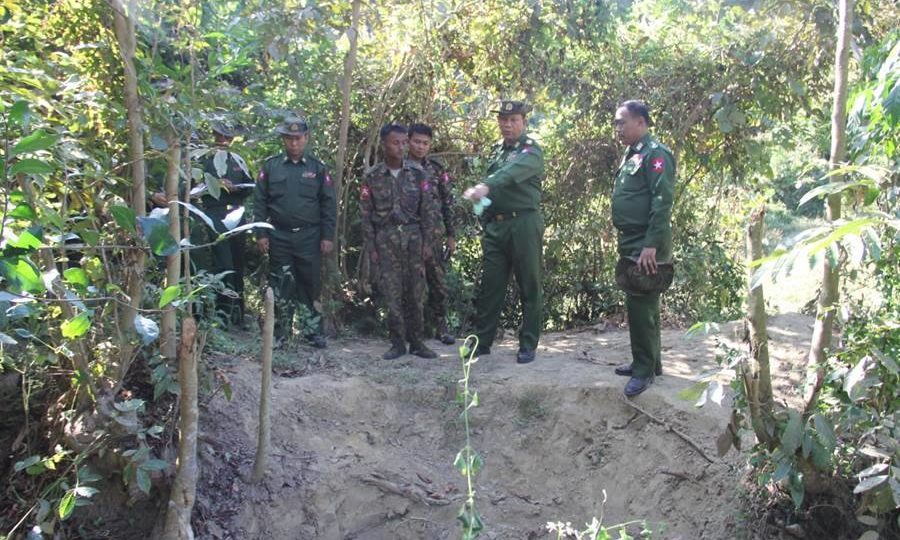Myanmar troops took part in a massacre of 10 Rohingya Muslims in northern Rakhine State in September, the office of Commander-in-Chief Min Aung Hlaing announced on its Facebook page on Wednesday.
This is the first time the Myanmar military has admitted to abuses since it launched military operations that have displaced more than 650,000 Rohingya from the country since August 2017.
The Facebook post also said the massacre took place at a cemetery in the ethnically mixed Inn Din village, where tensions between Rohingya and Rakhines were high after a Rakhine man named Maung Ni was allegedly killed by armed Rohingya in the area on Aug. 25. Rohingya villagers had allegedly also been threatening their Rakhine neighbors for days by carrying weapons around the village and blasting Rohingya-language content on loudspeakers.
According to the military’s account, the village erupted when 200 armed Rohingya militants attacked security forces there on Sept. 1. Security forces fired shots into the air to disperse the attackers and arrested 10 men. (Other accounts say the 10 men were not involved in the attack.)
The troops initially sought to bring their captives to a local police station “in accordance with procedure,” but the area was engulfed in conflict between security forces and Rohingya militants. Instead, they brought their captives to the local cemetery on Sept. 2 and killed them there.
“Some villagers from Inn Din village and security members confessed they killed 10 Bengali terrorists,” the Facebook post said, using a term that implies that the Rohingya reside in Myanmar illegally.
Eleven has reported that 10 villagers were at the cemetery at the time of the massacre, and three of them, including two sons of Maung Ni, executed the captured Rohingya men with swords. Four soldiers joined in by shooting the victims.
“Action will be taken according to the law against villagers who were involved and security members who broke the Rules of Engagement,” the commander-in-chief’s Facebook post said. “Action will also be taken against those officers who failed to report the incident to higher commands and against commanders who were responsible for those involved.”
The military’s telling of these events is based on interviews with security forces, local officials, and villagers conducted by the five-person investigative team led by military inspector general Lt.-Gen. Aye Win between Dec. 20 and Jan. 2.
The team’s findings in this investigation mark a wide departure from its history of justifications and acquittals. A previous investigation conducted by the team in November claimed that security forces had not committed any illegal killings or any other abuses in its crackdown against Rohingya militants.

Mass Grave
The team’s findings also confirmed that the 10 victims of the massacre were buried in a mass grave in the Inn Din village cemetery. The commander-in-chief’s Facebook page first announced the discovery of the mass grave on Dec. 19 and said the military would investigate the deaths and take legal action against those responsible.
The discovery of the mass grave came less than a week after two Reuters reporters were arrested in Yangon for possessing “important security documents.” Five ethnic Rakhine residents of Inn Din village were also arrested that week, and a relative of one of the detained villagers told the New York Times that they were arrested for passing photos and documents to Reuters reporters.
The relative did not describe what the photos and documents contained, and Reuters has declined to link the arrest of its reporters to the mass grave. However, others have theorized that the arrests of both the reporters and the villagers were an attempt to suppress reporting on a suspected massacre.
It may not be a coincidence that this admission was issued on the same day that the two Reuters journalists, who had reportedly been investigating that incident and grave, were formally charged under the Official Secrets Act. https://t.co/dFylxJGxvZ
— Richard Horsey (@rshorsey) January 10, 2018
Whether it is related to the case of the Reuters reporters or not, the military’s owning up to the massacre confirms what Rohingya refugees in Bangladesh have long told rights groups and media outlets – that security forces and ethnic Rakhine mobs have carried out a campaign of rape, arson, and killing against Rohingya civilians under the guise of counter-terrorism operations.





Reader Interactions